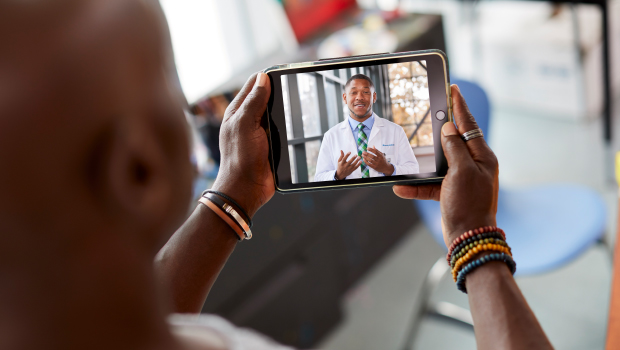Evaluating approaches to address equitable access to telehealth

New study sheds light on virtual care delivery among vulnerable patients
Once considered an industry niche, telehealth entered the mainstream during the COVID-19 pandemic. In February 2021, Kaiser Permanente Community Health launched the Virtual Care Innovation Network (VCIN) to support the equitable adoption and spread of telehealth through community health centers. Spanning 8 states and Washington, D.C., VCIN was a partnership with the Center for Care Innovations and the National Health Care for the Homeless Council.
The Center for Community Health and Evaluation (CCHE), part of Kaiser Permanente Washington Health Research Institute (KPWHRI), conducted a 15-month evaluation of VCIN. This evaluation sought to understand the use of telehealth across the network. It evaluated changes in organizations' capacity to serve their patients via telehealth. It also identified best practices and challenges for delivering virtual care.
"The evaluation provided an opportunity to learn from community health centers' efforts to address barriers that certain populations had accessing telehealth — particularly vulnerable patients," said Maggie Jones, MPH, CCHE director and co-principal investigator on the VCIN evaluation.
VCIN: Equitable access to virtual care
The widespread adoption of telehealth across the health care system happened during the response to the pandemic. During VCIN, organizations stepped back to review their processes, make improvements, and determine if there were segments of their patient population that were being left behind. Through VCIN, organizations tested strategies to address patient barriers.
VCIN provided grant funding to community health centers — clinics that primarily deliver health services to vulnerable patients — to participate in a learning collaborative that focused on improving equitable access to telehealth. This collaborative focused on reducing barriers for patients experiencing homelessness and patients with limited English skills. Fifty-seven health centers and 12 state/regional primary care associations participated in the program, which was divided into 3 tracks:
- In the Applied Project track, participants implemented a specific telehealth improvement project using design thinking and quality improvement tools.
- The Clinic Connection track focused on learning collaborative participation. Organizations shared experiences and lessons.
- Finally, the state/regional primary care associations participated in the Policy track. They monitored and shared lessons about the telehealth reimbursement policy.
CCHE’s evaluation: Key findings
The evaluation of VCIN resulted in several key findings. During the 15 months, telehealth use comprised about a third of primary care visits (31%) and two-thirds of behavioral health visits (64%), on average. Audio-only visits made up most of the telehealth visits (80% for primary care and 70% for behavioral health). A smaller percentage of visits were via video. During VCIN, the long-term reimbursement policy for telehealth was uncertain, especially for audio visits. This uncertainty drove some health centers to focus on using more video visits, which were more likely to be reimbursed.
To expand telehealth access, health centers focused on building telehealth infrastructure. The infrastructure adaptations included changing staffing models, developing workflows, adopting new technology, and supporting patients to use and access needed technology (such as patient portals and video visit platforms).
Some patients experienced more significant barriers in accessing telehealth services. So, health centers tested strategies for helping patients overcome these barriers. For example, health centers focused on increasing telehealth access for patients experiencing homelessness. VCIN partnered with permanent supportive housing programs and shelters to engage this patient population. They also integrated telehealth into street medicine through mobile units.
The evaluation also found that participating in the VCIN learning collaborative contributed to health centers' progress. Participants noted that the peer learning opportunities were the most valuable part of participation. In addition, individual and group coaching helped teams clarify their goals and work through challenges.
What is next for increasing access to telehealth?
Health centers participating in VCIN indicated that, although they initially implemented telehealth in response to the pandemic, telehealth would continue to be essential. They noted that telehealth options helped to ensure more equitable access to care for patients with barriers getting to the clinic.
At the end of VCIN, health centers reported a commitment to continuing telehealth expansion, especially for behavioral health. Health centers found that telehealth acceptance was higher for both patients and providers in behavioral health. Given that behavioral health access is often limited, offering telehealth options appeared to be a promising strategy to increase access.
"Through VCIN, health centers tested strategies that would help them support their patients accessing telehealth," said Natasha Arora, MS, co-principal investigator on the VCIN evaluation. "We learned a lot about what it takes to initiate these strategies, but most health centers were still in the process of testing and refining their strategies at the end of VCIN. There are opportunities for future investment in implementation and evaluation to continue to explore strategies that were tested through VCIN over a longer period to understand the impact, as well as support health centers in overcoming challenges with technology that may limit their telehealth success."
While telehealth is a promising approach to increase access for many, health centers found it was not the best solution for all patients. Patients who engaged less with telehealth cited digital barriers, concerns with online privacy or security, and the desire for an in-person connection.
Jones said, "We hope the learnings from the evaluation provide insights to health centers that are continuing to improve their telehealth practice and ensure that all patients can benefit from having multiple options to access care in the way that works best for them."
By Grant Clark, Center for Community Health and Evaluation
CCHE

Learn more about Center for Community Health and Evaluation
CCHE helps you find out what works to make communities healthier.
Healthy findings blog

Preventing heart attacks, strokes through health management
How the PHASE program improved care for people at risk of cardiovascular disease.
Innovations in Care

Future is now: Virtual care is transforming health systems
Katie Coleman describes how the pandemic boosted adoption of telehealth and how research is vital for it to thrive.


